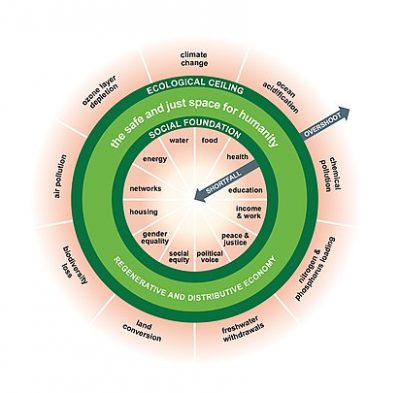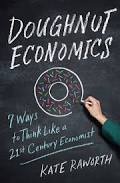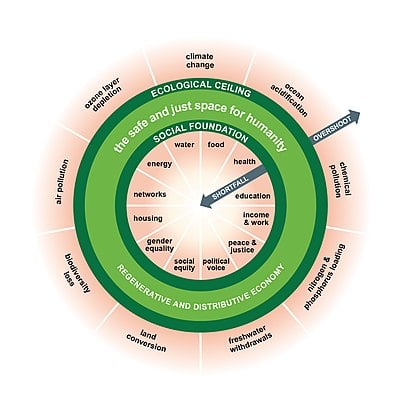“Doughnut Economics”: Seven Ways to Think Like a 21st-Century Economist
Review and Critical Analysis of Kate Raworth's Book

Kate Raworth calls herself ‘a renegade economist’. She was born in 1970 and earned a bachelor’s degree in Politics, Philosophy and Economics and then followed it with a master’s degree in Economics for Development, both from Oxford University where she is now employed.
She has worked for the United Nations where she coauthored a report for its Development Program, that’s a program promoting projects that are sustainable. She also spent a decade as a Senior Researcher for Oxfam. That position especially interests me because I was a delegate at the Oxfam International meeting in 1974 when the decision to focus on the causes of poverty was reinforced.
She has been named by The Guardian as one of the top ten tweeters on economic transformation, how is that for a modern accolade!
 Early in her studies, she noticed a simplistic graphic which was used in the most popular textbook at that time to explain how economics worked, it’s pictured below. She learned to see is as flawed. It showed what appeared to be the neutral, simple and apparently fair system shifting value from the public to business and back again. The world she knew was not that simple.
Early in her studies, she noticed a simplistic graphic which was used in the most popular textbook at that time to explain how economics worked, it’s pictured below. She learned to see is as flawed. It showed what appeared to be the neutral, simple and apparently fair system shifting value from the public to business and back again. The world she knew was not that simple.
The model didn’t account for money taking routine trips outside this circle, nor did it account for the free labor that is given to parenting, or elder care, or volunteering, time spent on the arts or social campaigns, all of which enrich our lives and are outside the model. Her biggest worry was about how this simplified model distorted thinking and insulated economics from the real world.
She learned to see is as flawed. It showed what appeared to be the neutral, simple and apparently fair system shifting value from the public to business and back again.
The world she knew was not that simple. The model didn’t account for money taking routine trips outside this circle, nor did it account for the free labor that is given to parenting, or elder care, or volunteering, time spent on the arts or social campaigns, all of which enrich our lives and are outside the model. Her biggest worry was about how this simplified model distorted thinking and insulated economics from the real world.
This chart was in Paul Samuelson’s immensely influential 1948 book ‘Economics’. You can read more about it and him here; http://www.aninsidersmemoir.com/economics-by-paul-samuelson-a-retrospective-book-review/
So, she took it on herself to create a model that she thought more accurately reflected the real world.
The doughnut was the result, the circle with a hole in the middle which she explains is a ‘playfully serious approach to framing the challenge we face’.
The doughnut places life’s essentials in the centre; food, water, income and health care for example, and just to state the obvious, none of these are seen as critical in traditional economics. In the outer ring are our challenges; pollution of water and air, climate change, the loss of biodiversity and the limits to farmland. For us to survive we need to live within the constraints we’ve been given.
Raworth has written an extensively documented book explaining why we require a whole new paradigm of thinking and this she has condensed into her seven ways to think like a 21’st Century Economist.
They require us to change our priorities from those we’ve been taught, to new goals that are designed to sustain us. We need to give up exploiting the planet for short term riches. We need to give up the goal of ever increasing growth. That will take effort because we are so programmed to seeing growth of the GDP as fundamental and essential. The fact is, it’s just not sustainable.
We also need to focus economics on our true nature. If it wasn’t for our caring nature, our children would never survive. For their first many years they totally depend on parental care. That’s our nature. What is not our nature, is the neocon explanation that we are driven solely by greed, the greed is good philosophy that has been dumped on us.
Her seven goals include adopting a system that fairly distributes what we produce. No longer should we accept that inequality is an unavoidable rule of economics. Similarly, and probably her biggest change, is that we no longer accept the myth that economic growth is essential. What is essential is our ability to survive! We need a system that will sustain us for our next generations. We need to, as she writes, become agnostic about growth.
And possibly the most interesting lesson from Raworth’s book is her view that “we are all economists now.” No longer does the church or public morality dominate our world, those now obsolete forces have been usurped by markets. Now, it’s all about money and wealth and the assumptions the fans of markets bring with it. These factors are reinforced by minute to minute stock marked reports as if they are what life is all about.
She sees herself as a glass half full person, as she says ‘ours is the first generation to deeply understand the damage we have been doing to our planetary household, and probably the last generation with the chance to do something transformative about it.’
She has provided us with a guide book to help insure our survival. It is well worth reading.
The path we are currently on is leading to our demise.
Economic analyst and author Bryant Brown is a frequent contributor to Global Research
*
Note to readers: please click the share buttons above or below. Forward this article to your email lists. Crosspost on your blog site, internet forums. etc.



